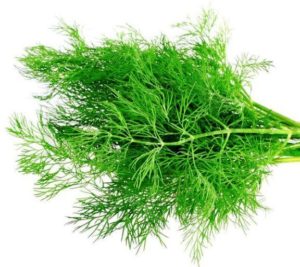Dill -(Anethum graveolens ) Umbelliferae Annual

Dill originated from Mediterranean lands and southern Russia, even thought the herb has been naturalized for centuries in many other countries, for centuries in many other countries, and is seen growing wild along roadsides and in fields where conditions are suitable. At first sight the ferny appearance of the foliage makes it difficult to distinguish dill from fennel , but on closer inspection it can be noticed that fennel’s leaves are a light, bright green colour, and when biting into a feathery leaf the flavour and aroma are reminiscent of licorice or aniseed. Dill is more fragile looking, the foliage almost a blue- green and the flavour of the leaves is distinctive, much “dryer”, and slightly peppery and spicy.
Seed may be sown in spring (and autumn in mild climates) in a sunny, sheltered position in light, well- drained soil. When in flower in spring and summer, it is 90 cm (3ft) in height. The pale yellow blooms are typically umbelliferous in shape, spreading and expanded like an open umbrella. Each flower head is made up of about 24 wiry stalks, the outer ones being longer than those in the middle, carrying approximately 20 minute florets, each one on the tiniest stem imaginable. Pick a floret on its thin stalk from the composite bloom and see how like a fairy bouquet it is. When the flower head has dropped its petals, oval flat seeds will have formed. For harvesting, cut the heads and lay them in a box, sun – dry them for a few hours, then shake out all the seeds and sieve them to remove the husks. Store in an airtight , labeled container.
In the garden, dill is helpful to certain plants in the vegetable patch: corn, lettuce and cucumber, for in stance. Bees are attracted to the pollen- laden flowers.
The herbal and astrological specialist, Dr Culpeper, says : “Mercury has dominion over this plant and therefore it strengthens the brain”
Uses:
Culinary – The pungent taste of dill leaves make them an excellent flavouring for almost any food. Try dill instead of parsley sometimes. When finely chopped, the leaves are delicious in mashed potatoes, cream cheese, white sauce, omelettes, any fish or shellfish dishes, salads, soups, cooked buttered vegetables, and as a flavouring for vinegar. The chopped leaves are delicious when spread over lamb, veal or chicken when roasting, with more stirred into the gravy before serving. The leaves, and sometimes the flowers and seeds as well, are used to make “dill pickles”.
Although dill leaves have some valuable constituents, there is greater nutritional and medicinal value in the seeds. Dill seeds or fruit, like other umbhellieferous seeds, contain volatile oils which are stimulating to the system, disperse flatulence, and are also soothing to the nerves. Dill seed can be added to gas-forming vegetables such as cabbage, when making sauerkraut, coleslaw, or steaming it as a vegetable,, to make it easier to digest. They can also be used with cucumbers, onions and some root vegetables, as well as pastries, breads, and some sauces.
Medicinal – Dill water helps soothe and calm babies who are troubled with flatulence and is a very old remedy going back to the days of the Norse people. (Dill is also said to have properties which strengthen the fingernails). Oil of dill is sold by some chemists for digestive upsets; such a sugar cube with a few drops of the oil added to it. Dill soup, made from the leaves, chicken stock and egg yolks, is nutritional and delicious.





